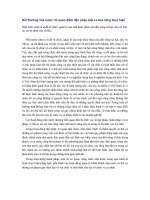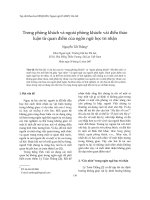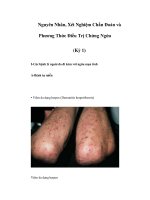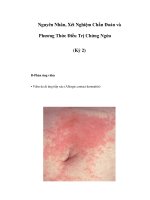Điều trị chứng tự kỷ từ quan điểm châm cứu
Bạn đang xem bản rút gọn của tài liệu. Xem và tải ngay bản đầy đủ của tài liệu tại đây (136.51 KB, 3 trang )
Jul 2011 Vol 4 No.3
164
North American Journal of Medicine and Science
Review
Autism Treatment from Acupuncture Perspective
Jing Liu, MD, PhD, Zeng Xiaoqing, MD, Ping Yao, MD
ABSTRACT
Although acupuncture has been used in the treatment of
autism for many years, almost no formal clinical trials
have been devoted to confirm the effectiveness of the
acupuncture for the disease in the western countries,
where a big population of children and family have been
suffering from the shortage of effective therapy. This
review is to summarize the reports from about 20 clinical
trials of acupuncture for autism in the last decade in
China. The results of these reports suggested that
acupuncture may be a potentially valuable approach in
treating autism. Around 80% symptom improvements
were stated in most of the studies. The reports also
demonstrated that acupuncture may enhance the
efficacies of conventional therapies for autism, such as
behavior rehabilitation therapy. It was suggested that the
effects of acupuncture for autism may be partially related
with its effects on anti-inflammation and on the
modulation of the brain signal conductivity, supported by
the research including fMRI. A concept of transcranial
electrical acupuncture stimulation (TEAS) is proposed.
Compared with the conventional acupuncture technique,
TEAS is hypothesized to target directly on the brain
lesions of autism through modulating hyperpolarized or
depolarized neurons of the brain, in order to improve the
pathological status of autism. Clinical trials are needed to
approve the proposal in the future.
[N A J Med Sci. 2011;4(3):164-166.]
KEY WORDS: Autistic spectrum disorder, acupuncture
The Centers for Disease Control and Prevention have called
autism a national public health crisis. Due to shortage of
effective therapeutic options in conventional medicine, many
interests have shifted to the alternative remedies. Growing
evidences support that acupuncture may be a potential
effective approach in treating autism. This commentary will
briefly review the update information of acupuncture on
autism and open the discussions on the clinical study of
acupuncture for the disease in the future.
Received 7/5/2011; Revised 7/25/2011; Accepted 7/25/2011
Jing Liu, MD, PhD,1 Zeng Xiaoqing, MD,2 Ping Yao, MD1
1. The Marino Center for Integrative Health, Cambridge, MA
2. Cheng Du University of Traditional Chinese Medicine,
Cheng Du, China
(Corresponding Author)
Jing Liu, MD, PhD
Email:
Although no clinical trials worldwide have presented
conclusive results on the effectiveness of acupuncture in the
treatment of autism, some clues can be obtained from the
clinical studies in the past decade. Reviewing the reports
from about 20 clinical trials published in the last 15 years,
with at least 30 cases in each study, the effective rates of
autism treatment with acupuncture were around 80%.
However, only a few of them were randomized controlled
studies. No obvious side effects or safety concerns have been
stated in these studies.1,2,3 Here are a few examples. A 202
case controlled study with autism showed that the effective
rate of the symptom improvement by acupuncture was
92.3%. Of the 78 and 58 severe patients, there were 92.3%
and 40.5% improvements in the acupuncture treatment and
control group respectively.4 Reported from a 50 case of
randomized
controlled
clinical
trials,
significant
improvements were observed in language comprehension,
self-care caregiver assistance, social initiation, receptive
language, motor skills, coordination, and attention span,
evaluated by the tests of Functional Independence Measure
for Children (WeeFIM), Pediatric Evaluation of Disability
Inventory (PEDI, Clinical Global Impression-Improvement
(CGI-I) scale, Aberrant Behavior Checklist (ABC), and
Reynell Developmental Language Scale (RDLS). In this
study, acupuncture induced. significant improvements in the
language comprehension domain of WeeFIM (p=0.02), selfcare caregiver assistant domain of PEDI (p=0.028), and CGII (p=0.003) in the electrical acupuncture group compared to
the sham control group.5 In a case of controlled study, 30
sessions of treatments were applied on 32 autism children to
test the effects of a acupuncture technique of Seven-star
Needle Stimulation for over 6 weeks. The results showed that
the acupuncture treatment induced significant improvement
in language and social interaction, but not in stereotyped
behavior or motor function, monitored by EEG (qEEG) with
the quantitative behavior measurement.6
The effectiveness of acupuncture was also evaluated in
comparison with other conventional medical approach. In a
clinical study of 40 cases, including those with severe autism,
acupuncture group using JIN's 3-needling technique
presented significant better results than that of the behavior
intervention.7 A report from a four month clinical trial
revealed that acupuncture, compared to piracetam treatment,
showed a more significant improvement on the language
comprehension.8 Acupuncture may be also potentially a
valuable adjuvant therapy to certain conventional treatments.
It was documented that forty autistic children received
rehabilitation training programs of ABA, Conductive
Education Approach and the sensory integration. Twenty of
those also received acupuncture treatment by end of the
rehabilitation training. There was a 55.0% markedly effective
North American Journal of Medicine and Science
Jul 2011 Vol 4 No.3
rate in the group using additional acupuncture, compared
with a rate 15.0% in the group with rehabilitation alone.9 The
studies above all selected some of internationally recognized
questionnaires to evaluate the changes of psycho-behaviorneural symptoms and the effectiveness rate of acupuncture
treatment. Those questionnaires include Aberrant Behavior
Checklist(ABC), Autism treatment evaluation checklist
(ATEC), Functional Independence Measure for Children
(WeeFIM), Pediatric Evaluation of Disability Inventory
(PEDI, Clinical Global Impression-Improvement (CGI-I)
scale, , and Reynell Developmental Language Scale (RDLS).
Overall, there is shortage of well designed randomized
controlled clinical trails to evaluate the true values of
acupuncture treatment for the autism. However, the
information obtained should be enough to encourage further
investigations.
The selections of acupuncture points have been various in the
above clinical studies. In general, the acupuncture points
were selected mostly based on the meridian theory in Chinese
medicine. Some of those points are thought act by “waking
up the brain and opening the orifice” in the theory. On the
other hand, the relatively newly developed scalp acupuncture
based on the brain anatomy has been commonly used in
almost every group of clinical studies of autism. The most
frequently used points of scalp acupuncture include: (1)
Three Acupoints of the Temple: GB 8, l cun anterior and
posterior to GB 8; (2) Three Wisdom Acupoints: GV l 2,
bilateral GB 1 3,GV 20; (3) Three Acupoints of Brain: GV
17, 1.3 cun left and right to GV 1 7; (4) Four Acupoints of
the Mind: Ex-HN 1(Si Shen Cong); (5) three points on the
occipital area: GVl5,GB20,GBl2.10 A few years ago, a
randomized controlled 50 case clinical trial of tongue
acupuncture was first reported being effective for autism. A
significant improvement in the treatment as compared to the
control group was seen in self-care and cognition domains of
the Functional Independence Measure for children. The
authors applied acupuncture on the tongue including points
of Ex•HN 1 2,Ex-HN l , and CV23.11
Quite a few new technologies have been developed in
evaluating the effectiveness of acupuncture in treating
autism, in addition to the subjective psycho-behavior tests.
One of the impressive works was from Dr. Jia Shaowei. His
group reported at 2008 that electrical acupuncture
significantly improved SPECT brain image of 78.95% in a 34
case clinical study, a result corresponding the clinical
behavior improvement. They suspected that the increased
blood flow and enhanced function in the prefrontal cortex,
broca and wernicke region could partially contribute such
changes.12 fMRI has been one of the most promising tool in
assessing the functional and structural changes of autism. For
example, growing evidences support that autism is an
inflammatory disorder of brain, evidenced by the fMRI
finding that the total volume of brain, cerebella and caudate
nucleus enlarged. The area of corpus callosum is reduced. 13
The inflammation may involve in the changes of the
neurophysiology of autism, characterized by a disturbance of
165
the signal conductivities, particularly, the exaggeration of the
excitatory signals and deficit of the inhibitory signals during
information processing. Such abnormal balance mostly exist
in the prefrontal and temporal cortex as well as deep nucleis
such corpus callosum.14 In fact, the anti-inflammatory
effects of acupuncture were explored in many studies.15,16
Acupuncture may down-regulate exaggerated neural activity
and generate a tranquilizing effect by enhancing GABAergic
enhancing efficacy.17 The results from Dr. Kathleen Hui’s
fMRI studies further suggested that acupuncture may
modulate the conductivity of cortico – limbic-subcortical
network.18
Another new technique used in the autism study was based
on the discovery that the activity of the sympathetic
autonomic nervous system is significantly altered in children
with autism. The authors measured 48 acupuncture points on
fingertips by using a biometric device capable of gas
discharge visualization (GDV). They found that the psychoemotional and physiological functional states of autism were
correlated with the enhanced activities of the autonomic
nervous system.19
So far, it seems that acupuncture is a potential approach to
benefit the children with autism. However, it is clear that the
ongoing knowledge and techniques of acupuncture need to be
further studied and improved. For instance, no autism
research of acupuncture has focused on the digestive system,
although the inflammation in gut system may play an
important role in the development of autism.20,21,22
Furthermore, acupuncture alone is not a complete solution for
autism, although many clinical studies suggested potent
benefits. We hypothesize that acupuncture may mostly affect
on the aspect of functional activities, probably including
neural conductivity ignition and signal transduction, which
may be similar to the concept of “Qi” effect of acupuncture
in the view of traditional Chinese medicine. Considering that
autism children have not only functional psycho-behavior
symptoms but also significant abnormalities in nutritional
abnormalities, such as essential fatty acid and phospholipids
metabolism, which may accompany with the inflammation
process and even the genetic disturbances.23,24 So, it is
reasonable to suggest that integration of acupuncture with
proper nutritional therapy based on the individual needs is
necessary.
The acupuncture technique itself needs to be upgraded based
on scientific evidences. fMRI found that the superior
temporal sulcus (STS) region is an important component of
the network of brain regions that support various aspects of
social cognition and social perception.25 Excessive signaling
may lead to hyperexcitable behavior as a result of shortage of
GABAergic functions in the area. The superior temporal
sulcus function may underlie many of the social and language
abnormalities seen in autism.26 Therefore, one of the major
targets of autism treatment should be on the prefrontal and
temporal-limbic region functions. From this point of view,
conventional acupuncture may not provide enough impact in
Jul 2011 Vol 4 No.3
166
these areas, because the acupuncture stimuli are usually
distant from the pathological lesions of the brain. Here,
transcranial electrical acupuncture stimulation (TEAS) is
proposed by Dr. Jing Liu based on the information review
and the preliminary clinical experiences.
The idea of TEAS is supported by the evidence of
transcranial direct current stimulation (tDCS).
tDCS
involves placing metal electrodes on the scalp and applying a
small and harmless electrical current across the cranium. The
current can hyperpolarize or depolarize neurons in the path of
the current.27 It was shown that tDCS over frontal cortex
enhanced retention of word learning.28 Stimuli of 1 mA
tDCS can induce a slight change in the resting potential of
the brain cells, resulting improvement of the information
process through modulating the depolarization thresholds of
neurons.29 Hence, we predict that TEAS may bring the
electrical current across the targeted regions of brain as tDCS
do, instead of the surface to surface stimulation of the scalp
acupuncture. Both traditional acupoints and the neural
anatomy should be considered when the acupoints of TEAS
are selected. Another advantage of TEAS found from the
previous clinical practice may be that the application is
painless and easier accepted by children than that of
traditional acupuncture. So far, we have little knowledge on
how such electrical current can affect the brain function of
those with autism. However, we predict that the targeted
treatment of the TEAS can be well measured and evaluated
by using modern techniques such as fMRI or EEG,
considering that the prefrontal and temporal gyrus are located
in the relative superior areas of the brain. Further
investigations are needed to confirm the hypothesis.
8.
9.
10.
11.
12.
13.
14.
15.
16.
17.
18.
19.
20.
21.
22.
Together, acupuncture seems a therapeutic approach which
may be beneficial to children with autism. However, more
qualified clinical trials are needed to approve the
effectiveness of acupuncture on the disease. TEAS, a new
technique of acupuncture is proposed to improve the efficacy
of acupuncture on autism treatment.
23.
24.
REFERENCES
1.
2.
3.
4.
5.
6.
7.
Li H. Clinical study on treatment of child autistic disorder by
acupuncture. Chinese Acupuncture & Moxibustion. 2004; 24(5):317319.
Guo X. The current treatment of TCM on autism. J Pediatrics of TCM.
2010; 6(5):48-51.
Zhang J. A review of autism spectrum disorders (ASD) from a
perspective of classical Chinese medicine (CCM). J Tradit Chin Med.
2010; 30(1):53-59.
Yuan Q, Wu ZF, Wang RC, Deng JJ, Zhou HL, Lang JY. Observation
on the therapeutic effect of acupuncture treatment of autism children.
Acupuncture Research. 2009; 34(3):183-187.
Wong VC, Sun JG. Randomized controlled trial of acupuncture versus
sham acupuncture in autism spectrum disorder. J Altern Complement
Med, 2010; 16(5):545-553.
Chan AS, Cheung MC, Sze SL, Leung WW. Seven-star needle
stimulation improves language and social interaction of children with
autistic spectrum disorders. Am J Chin Med. 2009; 37(3):495-504.
Yuan Q, Wang RC, Wu ZF, Zhao Y, Bao XJ, Jin R. Observation of
effect of Jin's 3-needling technique on severe autism. Chinese
Acupuncture & Moxibustion. 2009; 29(3):177-180.
25.
26.
27.
28.
29.
30.
North American Journal of Medicine and Science
Zhong QR, Yu RI, Pong J, Zhou YF, Zhou YJ. Efect of acupuncture
in improving intelligence and language disorder of autistic children.
Chinese Journal of Clinical Rehabilitation. 2005; 9(28): 11-14
Yan YF, Wei YY, Chen YH, Chen MM. Effect of acupuncture on
autism children with rehabilitation training. Chinese Acupuncture &
Moxibustion. 2007; 27(7):503-505.
Xi Y, Liu Y, Zhou AI, Zhang Q. Interference effect of acupuncture on
language function of children with Autism. J Acupunct Tuina Sci.
2010.8(4):226-229.
Wong YM. Tongue acupuncture and autism spectrum disorder. J Altern
Complement Med. 2010;16(12):1247-8.
Jia SW, Sun TT, Fan Ri. Visualized study on acupuncture treatment of
children autism using single photon emission computed tomography.
Chin J Integra Trad West Med. 2008; 28(10):886-889.
Hrdlicka M. Structural neuroimaging in autism. Neuro Endocrinol Lett.
2008; 29(3):281-286.
Casanova MF, van Kooten IA, Switala AE, et al. Minicolumnar
abnormalities in autism. Acta Neuropathol. 2006; 112(3):287-303.
Zijistra FJ, Lange IB, Huygen F, Klein J. Anti-inflammatory actions of
acupuncture. Mediators of Inflammation. 2003; 12(2):59-69.
Chung WY, Zhang HQ, Zhang SP. Peripheral muscarinic receptors
mediate the anti-inflammatory effects of auricular acupuncture. Chin
Med. 2011; 6(1):3-5.
Lee BH, Zhao RJ, Moon JY, et al. Differential involvement of GABA
system in mediating behavioral and neurochemical effect of
acupuncture in ethanol-withdrawn rats. Neurosci Lett. 2008;
443(3):213-217.
Hui KK, Liu J, Marina O, et al. The integrated response of the human
cerebro-cerebellar and limbic systems to acupuncture stimulation at ST
36 as evidenced by fMRI. Neuroimage. 2005; 27(3):479-496.
Jyonouchi H, Geng L, Ruby A, Zimmerman-Bier B. Int J Environ Res
Public Health. 2010; 7(5):1984-1995.
de Magistris L, Familiari V, Pascotto A, et al. Alterations of the
intestinal barrier in patients with autism spectrum disorders and in their
first-degree relatives. J Pediatr Gastroenterol Nutr. 2010; 51(4):418424.
Jyonouchi H, Geng L, Ruby A, Zimmerman-Bier. Dysregulated innate
immune responses in young children with autism spectrum disorders:
their relationship to gastrointestinal symptoms and dietary intervention.
B Neuropsychobiology. 2005; 51(2):77-85.
de Magistris L, Familiari V, Pascotto A, Sapone A, Frolli A, Iardino P,
Carteni M, De Rosa M, Francavilla R, Riegler G, Militerni R,
Bravaccio C. Alterations of the intestinal barrier in patients with autism
spectrum disorders and in their first-degree relatives. J Pediatr
Gastroenterol Nutr. 2010; 51(4):418-424.
Bell JG, MacKinlay EE, Dick JR, MacDonald DJ, Boyle RM, Glen AC
Essential fatty acids and phospholipase A2 in autistic spectrum
disorders Prostaglandins Leukot Essent Fatty Acids. 2004; 71(4):201204.
Brown CM, Austin DW. Autistic disorder and phospholipids: A
review. Prostaglandins Leukot Essent Fatty Acids. 2011; 84(1-2):2530.
Pelphrey KA, Carter EJ. Brain mechanisms for social perception:
lessons from autism and typical development. Ann N Y Acad Sci.
2008; 1145:283-299.
Redcay E, Courchesne E. Biol. Deviant functional magnetic resonance
imaging patterns of brain activity to speech in 2-3-year-old children
with autism spectrum disorder. Psychiatry. 2008; 64(7):589-598.
Fregni F, Boggio PS, Nitsche M, et al. Anodal transcranial direct
current stimulation of prefrontal cortex enhances working memory.
Exp Brain Res. 2005; 166(1):23-30.
Monti A, Cogiamanian F, Marceglia S, et al. Improved naming after
transcranial direct current stimulation in aphasia. J Neurol Neurosurg
Psychiatry. 2008; 79(4):451-453.
Stagg CJ, Best JG, Stephenson MC, et al. Polarity-sensitive modulation
of cortical neurotransmitters by transcranial stimulation. J Neurosci.
2009; 29(16):5202-5206.
Kostyuk N, Rajnarayanan RV, Isokpehi RD, Cohly HH. Autism from a
biometric perspective. Auton Neurosci. 2010; 157(1-2):81-90.









